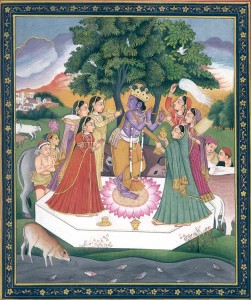Suddenly Sri Lilâshuk had a sphurti of Sri Krishna. He beheld Sri Krishna in front of him and said – “Right in front of me, there is an inexpressible ‘Vastu’.”
Why has the poet used the word ‘Vastu’?
Srila Kavirâj Goswâmipâd explains that, “He who is the eternal storehouse of all beauty, sweetness, intelligence and all other good qualities is ‘Vastu’.”
Sri Bhagavân reveals His qualities to a devotee according to the type and amount of love that the devotee may possess. Vraja is a land of sweet love. Over and above that, the damsels of Vraja are constantly in a state of Mahâbhâv. Hence, all qualities of Sri Krishna such as beauty, sweetness etc. is revealed to them to the maximum extent. Srila Kavirâj Goswâmipâd says, “’Vastu’ is the One who mesmerises even the ‘âtmârâm’ sages by His sweetness and plays the magical flute that enchants them and makes them faint; He is the One who verily enamours all creation, especially the hearts of the Vraja-beauties who are the best of all women.”
This ‘Vastu’ is eternally ‘Nava-Kishor’. The Vraja-gopis are chaste. They are homemakers and therefore not free to move about. Sri Krishna is worried – how will they arrive for the Râs-dance? If they do not come, how will the Râs-dance take place? Desirous to relish the Râs-ras, Rasik-Shekhar1 Sri Krishna played His flute. The song of the flute was so blissful that He Himself was bewitched. The Gopis went mad when they heard the song. They ran to Him and when He heard the tinkle of their anklets and kanchi2, His heart was put to rest. It became “nirvâna – nirvyâkulam” (peaceful and stress-free).
The Vraja–beauties focus on, are attracted by and are addicted to only one object – Sri Krishna’s lotus–feet. The elders of the family admonish them. They have to consider the family honour and social norms. All these are very strong shackles that bind them and obstruct them from meeting Sri Krishna. To liberate them from these shackles is His own prerogative – “hasta–nyasta nat–apavargam” meaning, ‘nothing can stop them from beholding Sri Krishna the moment they hear His all–enchanting flute.’ Sri Krishna Himself is telling them –
“ya ma bhajan durjara–geha–shrinkhalah samvrishchya tadvah prati–yatu sadhunâ”.
Meaning – “You have performed my bhajan by completely severing the invincible fetters of family and society.” – S.B.
Explanation of ‘akhilodaram’
This Object is ‘akhilodaram’ as well. He delights the hearts of damsels, so He is ‘akhilodar’. Poet Jayadev writes –
During the Vasanta–Râs3, a friend told Sri Râdhâ – “Dear sakhi! Behold how Sri Krishna has delighted all the Gopis and has aroused their bliss! He is celebrating the ‘Festival of Love’ with His very soft Shyâm-like form, resembling a host of blue lotuses, and the Vraja–beauties are embracing Him in every possible way. Thus, He is freely sporting in this ‘Spring Festival’ like erotic ras personified.”
Another meaning of ‘akhilodaram’ is – This ‘Vastu’ is generously attributed with many worshipped qualities and in this respect, no one can beat Him or even equal Him. In qualities such as – loving the devotees, being merciful, enjoying sweet pastimes, displaying sweet love, playing on the sweet flute and revealing His sweet beauty, Vrajendra-Nandan Krishna is unsurpassed. Thus, Râs-Rasik-Shekhar4 Sri Krishna alone is Lilâshuk’s worshipped ‘Vastu’. Srila Kavirâj Goswâmipâd has written –
“To relish special ras in the kunja – which means – to perform confidential pastimes with Sri Râdhârâni, Sri Krishna cleverly beckoned Her with His eyes, from amidst the millions of Vraja-Gopis, to a secluded spot and started the Râs-dance.”
The above-mentioned verse is a reflection of Sri Lilâshuk’s third verse. The first part of the third verse refers to how Sri Krishna beckoned to Sri Râdhâ with a mischievous signal of His eyes and took Her to a secluded kunja. He definitely uses some of His best qualities – that is – the waves of nectarine lâvanya and covetous glances for this purpose. The bank of the River Kâlindi is the stage for the Râs-dance. It is needless to say that the Râs-rasik Sri Krishna is a realm of infinite sweetness. If Srila Kavirâj Goswâmipâd had not explained the bhâv of this verse, it would have been impossible for the readers to delve into greater depths of bhâv. Anyhow, Srila Kavirâj Goswâmipâd has given two explanations for this verse. He has said –
“I shall explain the meaning arising out of the external feeling (as a sâdhak) in short and the real meaning arising out of internal feeling (in siddha-deha) in details.”


4 thoughts on “Verse 2- Part 7 – A siddha-swarup’s relish of ‘vastu’ and ‘akhilodaram’.”